Coronavirus Today: Vaccine mandates gain momentum
Good evening. I’m Karen Kaplan, and it’s Friday, Sept. 10. Here’s the latest on what’s happening with the coronavirus in California and beyond.
With large groups of Americans continuing to resist the call to get vaccinated against COVID-19, frustrated public officials are increasingly deciding that they can’t afford to keep waiting for these holdouts to come around on their own. With more than 1,000 Americans dying of COVID-19 each day — the vast majority of them unvaccinated — they are pulling the trigger on vaccine mandates.
At the White House, President Biden escalated his administration’s efforts to compel Americans to roll up their sleeves with a series of initiatives that will affect tens of millions of workers. And in Los Angeles, the Board of Education approved a sweeping order that makes full vaccination a condition of attending in-person school for all students old enough to be immunized.
The vaccine mandate for L.A. Unified schools is the first of its kind among the nation’s largest school districts. Local officials estimate that about 80,000 L.A. Unified students who are eligible for a COVID-19 vaccine have not yet received it.
Experts say millions of students elsewhere could face increasing pressure to get vaccinated if other districts follow L.A.’s lead.
The school board’s vote “could provide the model for a comprehensive school response to COVID mitigation,” Odis Johnson Jr., executive director of the Center for Safe and Healthy Schools at the Johns Hopkins University School of Education, told my colleague Howard Blume. “Mandatory vaccination mandates move us forward toward finally addressing students’ developmental, social and academic well-being.”
In New York City, home to the only school system larger than L.A.’s, only athletes who participate in high-contact sports are required to get vaccinated. New York, L.A. and Chicago, the nation’s third-largest district, have all enacted vaccine mandates for school employees — and more are joining them.
Biden’s moves will force healthcare workers at facilities that receive federal funding through Medicare or Medicaid to be vaccinated. So will teachers whose programs are funded by Head Start or Early Head Start programs.
People employed directly by the federal government, or who were employed indirectly as contractors, used to have a choice between getting the shots or being tested for a coronavirus infection once a week. The hope was that the inconvenience and discomfort of testing would make the vaccine a more appealing alternative. Now weekly testing is no longer an option — and workers who aren’t fully vaccinated in three months could be subject to disciplinary action.
(A person is considered fully vaccinated two weeks after getting their second dose of either the Pfizer-BioNTech or Moderna vaccines, or their only shot of Johnson & Johnson’s vaccine.)
Biden’s new rules extend beyond government workers. The Occupational Safety and Health Administration will require companies with at least 100 employees to make sure all workers are either vaccinated or get tested weekly. Failure to comply could result in a $14,000 fine.
The Food and Drug Administration has authorized or approved COVID-19 vaccines for all Americans ages 12 and up. Nearly 178 million U.S. residents are fully vaccinated, and almost 31 million more are partially vaccinated. That still leaves roughly 80 million people who could be vaccinated but aren’t.
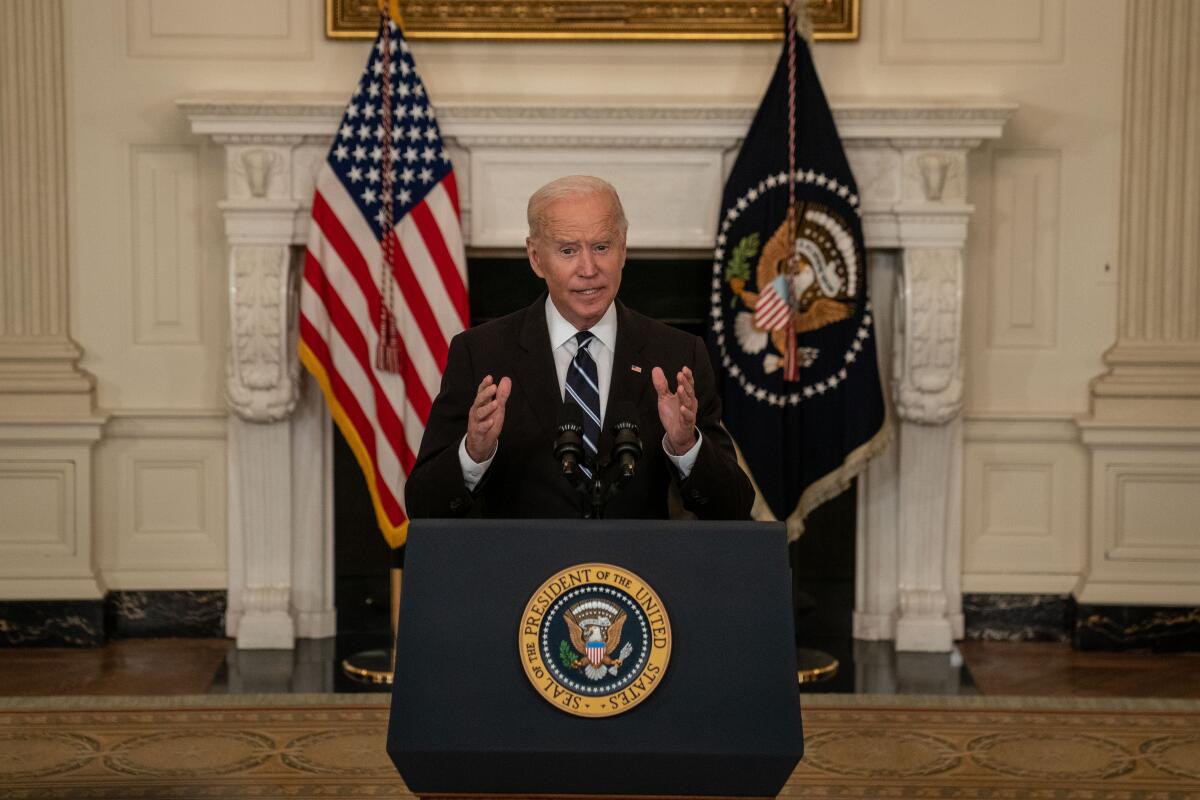
Biden, for one, is baffled by their hesitation. “What more is there to wait for?” he said Thursday. “We’ve made vaccinations free, safe and convenient…. We’ve been patient. But our patience is wearing thin. And your refusal has cost all of us. So please do the right thing.”
The president elaborated on that last point: “This is not about freedom or personal choice. This is about protecting yourself and those around you.”
Indeed, a report published Friday by the Centers for Disease Control and Prevention underscored just how much people are risking by not getting the vaccine.
Researchers compiled data from 10 states (Alabama, Arizona, Colorado, Indiana, Louisiana, Maryland, Minnesota, New Mexico, North Carolina and Utah) and three metropolitan areas (Los Angeles County, New York City and Washington’s King County, home of Seattle) and counted 6,748 COVID-19 deaths between April 4 and July 17, a period during which the Delta variant rose to prominence around the country. Fully 91% of those deaths occurred in people who were not vaccinated.
The younger the age group, the greater the imbalance. Among people between the ages of 18 and 49, 99% of the people who died in the first 11 weeks of the study period were unvaccinated, as were 96% of those who died in the last four weeks. Despite these lopsided figures, these younger adults are less likely to be vaccinated than people who are at least 50 years old.
A survey released last month by the Kaiser Family Foundation found that unvaccinated adults were less likely than their vaccinated counterparts to think they would become seriously ill if they became infected with the coronavirus. As a result, they were more likely to think it was riskier to get the vaccine than to take their chances with the coronavirus.
The data say otherwise. For instance, a study published last month in the British Medical Journal found that the risks of developing serious blood clots, strokes and heart attacks are all significantly higher if you have an infection than if you get the vaccine.
(Here’s what the Baltimore City Health Department has to say to those who think they’re too young and healthy to benefit from COVID-19 vaccines.)
There was hope that the FDA’s decision to grant full approval to Pfizer’s COVID-19 vaccine on Aug. 23 would prompt some holdouts to get it, but that doesn’t seem to be the case so far. My colleagues Rong-Gong Lin II and Luke Money ran the numbers and found that 2.91 million Americans got their first dose of any COVID-19 vaccine in the week before the FDA action, compared with 2.78 million in the week after. That’s a 4.4% decline.
However, the number of first doses administered increased from 10 million in July to 14 million in August. That’s probably a response to the Delta surge.
But sometimes people don’t recognize how dangerous the virus is until it’s too late. The sooner vaccine mandates are implemented, the fewer people will have to learn this lesson the hard way.
By the numbers
California cases and deaths as of 4:45 p.m. Friday:

Track California’s coronavirus spread and vaccination efforts — including the latest numbers and how they break down — with our graphics.
The NFL’s secret COVID-19 plan
A new NFL season is upon us. Before we get caught up in the first weekend of play, let’s pause a moment to appreciate this remarkable fact:
The National Football League has not canceled a single game due to COVID-19.
Even when the pandemic was at its worst, the league staged 12 playoff games in January and then capped things off with an upset victory by Tom Brady and the Tampa Bay Buccaneers in Super Bowl LV.
Major League Baseball shortened its regular season from 162 games to 60. The National Basketball Assn. sealed off 22 teams in an Orlando, Fla., bubble.
That’s not to say the NFL’s first pandemic season was completely normal — it certainly wasn’t. Teams played in empty stadiums, games were repeatedly postponed, and in Week 12, the Denver Broncos tapped a practice-squad receiver to be their starting quarterback.
But in a year when football fans were most in need of an escape, the NFL pulled off a Hail Mary play for the ages.
“History will look back at last year and say it was more than just a little remarkable that we were able to play the season uninterrupted,” Indianapolis Colts owner Jim Irsay told my colleague Sam Farmer.
How did they do it?
It took close cooperation between management and players, a rigorous coronavirus testing program, and a willingness to enforce its safety protocols, even when they were unpopular. Lessons learned during the 2011 player lockout also came in handy, including the need for all sorts of contingency plans.
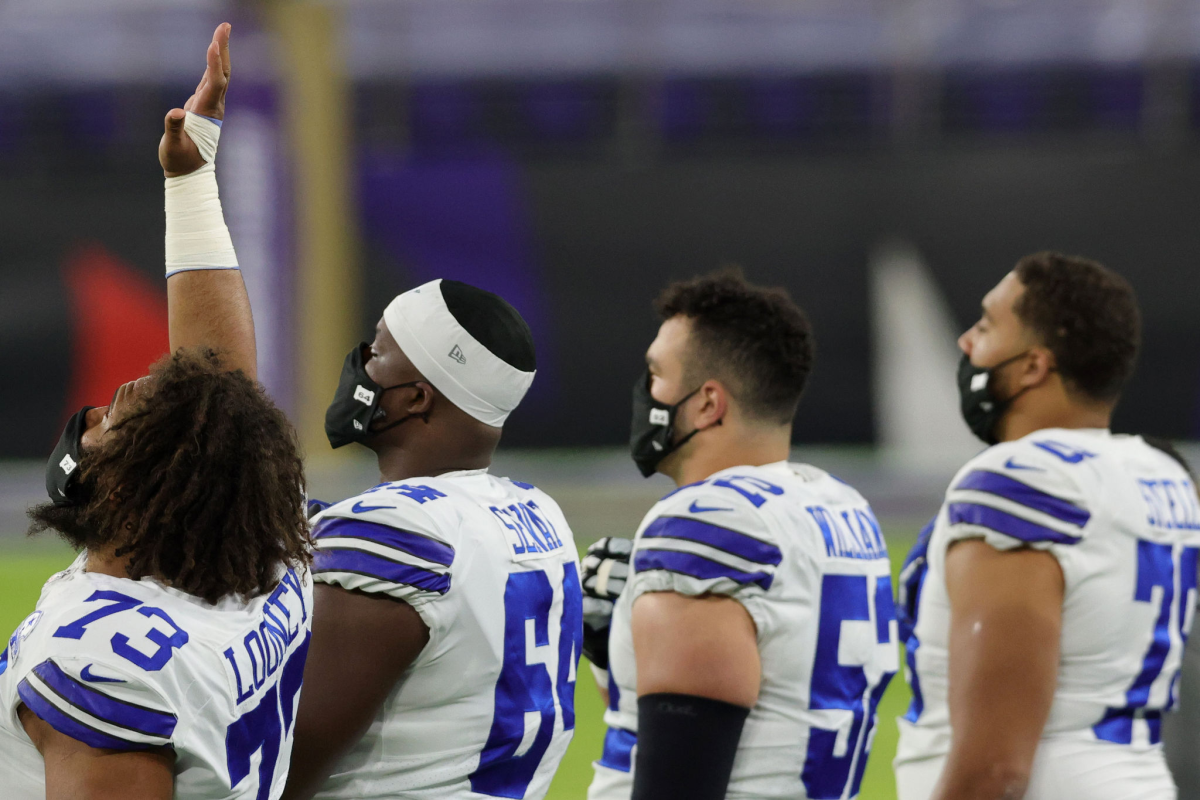
Peter O’Reilly, the league’s executive vice president of club business and league events, credited Commissioner Roger Goodell for keeping his eyes on the prize.
“He had this North Star of, ‘We are going to get through this,’” O’Reilly said of Goodell. “It was, ‘We’re going to follow the docs and the science. We’re going to do right by the players and clubs. We’re going to do right by our fans. We’re going to model the right behavior and use our platform in a positive way.’”
The first challenge was conducting a virtual draft. Even some of Goodell’s biggest skeptics had to acknowledge that the three-day event was surprisingly successful.
But practices and games could not occur virtually. When training camps opened, coronavirus tests were administered daily. By the time the regular season ended, a total of 954,830 tests were performed on more than 7,000 people.
To prevent outbreaks from spiraling out of control, the league required everyone to wear a domino-sized electronic device called a SafeTag that recorded the proximity and duration of contact between users. That simplified contact tracing when someone tested positive.
(The Broncos got busted for trying to cheat the system by having four quarterbacks remove their SafeTags and plant them in different corners of a meeting room before huddling close together to watch game film. The trickery was captured on surveillance video.)
The fact that no games were canceled was one measure of the NFL’s success. Another was this: The number of positive coronavirus tests declined even as the pandemic got worse.
The league stayed busy during the offseason, urging players to get vaccinated and instituting steep consequences for teams that don’t take advantage of the shots. As a result, more than 90% of players have received at least one dose.
The new season got underway Thursday night, with another rousing Tampa Bay victory. Though things seem less uncertain than they did a year ago, the Delta variant is still surging and anything can happen.
Can the NFL pull off a repeat performance? Larry Ferazani, a deputy general counsel for the league, sure hopes so.
“If we don’t get through ’21 and play every game,” he said, “then everything we did in ’20 is forgotten.”
California’s vaccination progress
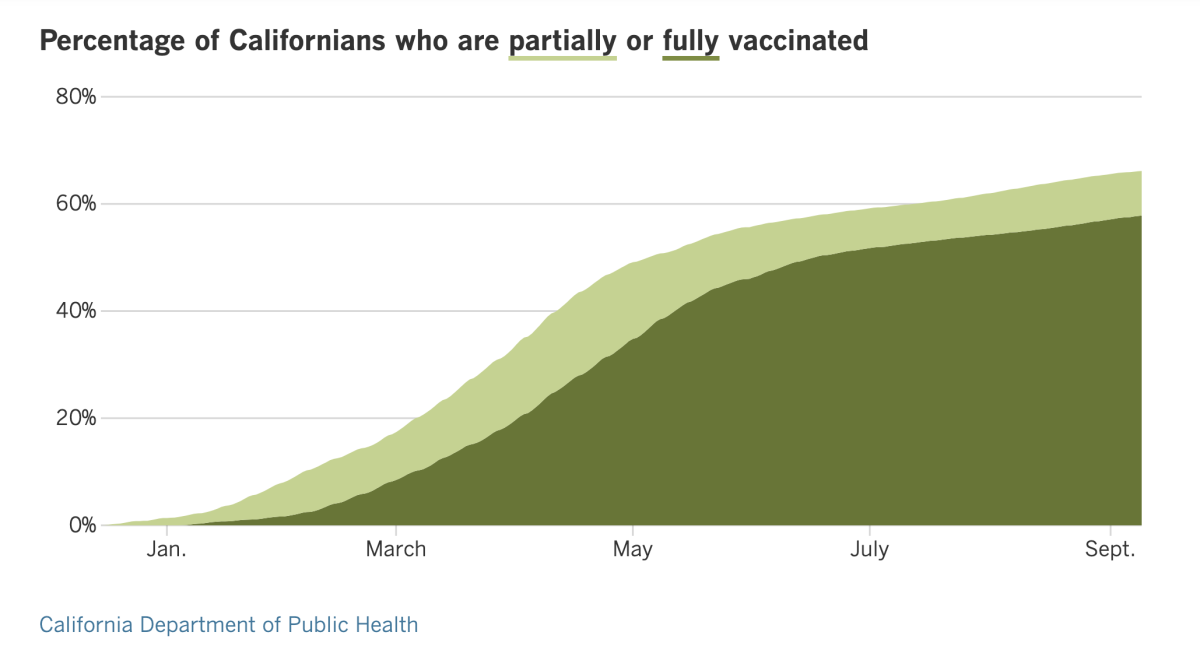
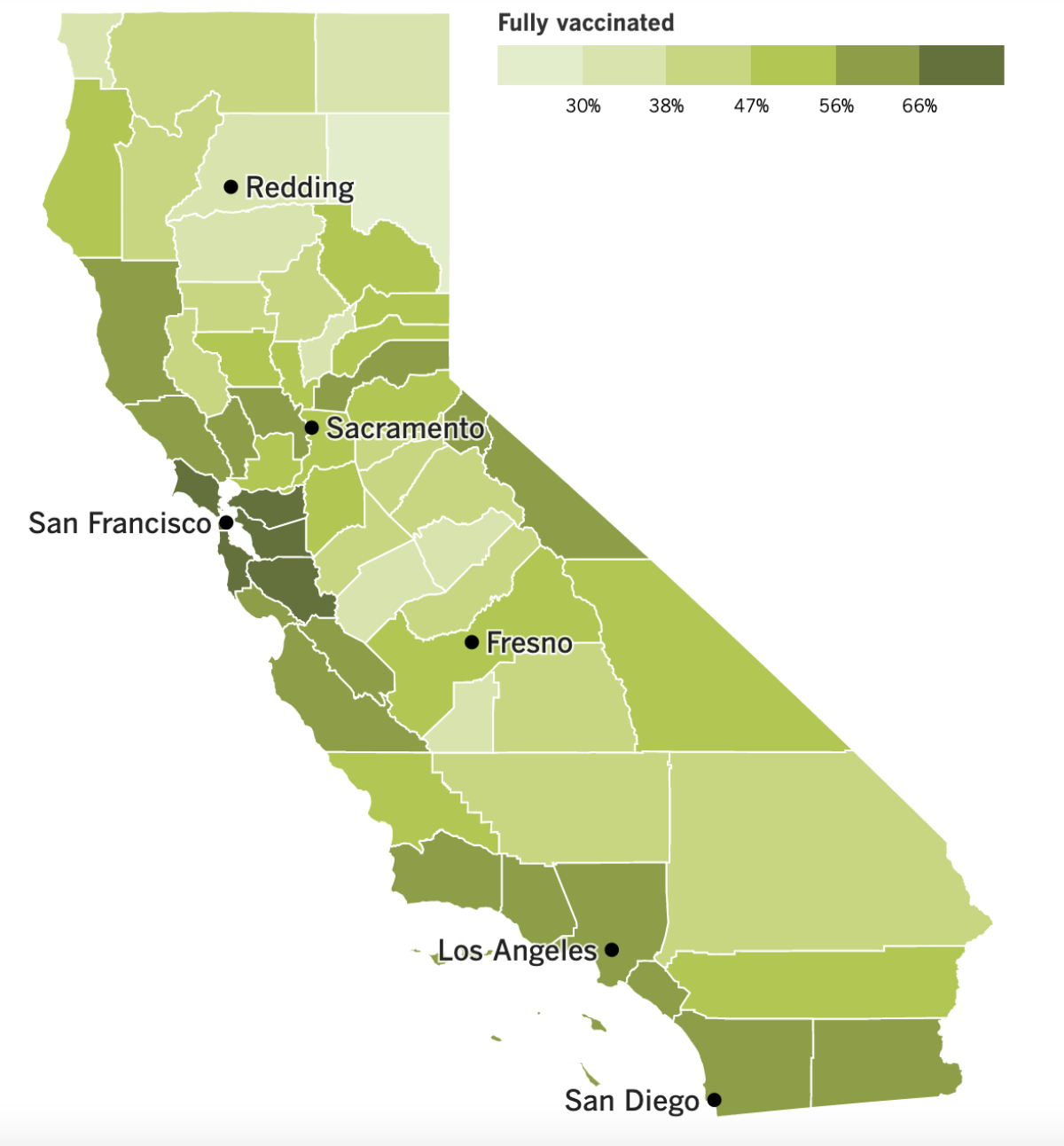
See the latest on California’s vaccination progress with our tracker.
Consider subscribing to the Los Angeles Times
Your support helps us deliver the news that matters most. Become a subscriber.
In other news …
Though vaccine mandates are gaining momentum, they aren’t catching on everywhere. A second effort to institute a vaccine mandate in California workplaces fizzled out before the state’s legislative session came to a close this week.
Assemblyman Evan Low (D-Campbell) took up the cause after a proposal by his colleague Buffy Wicks (D-Oakland) fell apart last week. But neither was able to get their proposed language into a bill.
Low said he had reached a deal with the California Labor Federation and the California Chamber of Commerce that included explicit authorization for employers to require their workers to be vaccinated against COVID-19. Businesses hoped the clarity would shield them from potential lawsuits. But the whole thing failed to come together before lawmakers left Sacramento.
“It’s unfortunate and very frustrating we couldn’t get this done,” Low said. “We ran out of time.”
Kids under 12 are too young to be vaccinated, but coronavirus case rates for children of all ages have been falling in Los Angeles County. That’s particularly impressive considering that 1.5 million youngsters in the county have returned to school in recent weeks.
Coronavirus cases among children here increased between mid-July and mid-August. Then they declined by about 30% over the last two weeks, in line with the trend seen in adults.
As of last week, children accounted for 27% of the county’s coronavirus cases. That’s higher than it’s been for most of the pandemic — the American Academy of Pediatrics and the Children’s Hospital Assn. say that kids have made up 15% of cases over the last 18 months as a whole. The recent jump is yet another sign that the risk of transmission is real in this largely unvaccinated segment of the population.
Among Angelenos of all ages, the average number of new cases per day was 33% lower over the last week compared with the week before. And COVID-19 hospitalizations have dropped nearly 24% since mid-August. But 27 residents of L.A. County are still dying of COVID-19 on a daily basis.
The Central Valley is becoming California’s COVID-19 hot spot, with hospitals filling and health officials raising alarms. They say things could get worse before they get better.
In the San Joaquin Valley, COVID-19 deaths have tripled from 93 in July to 311 in August. An additional 78 deaths were recorded in the first six days of September, which puts the region on pace for 390 deaths before the month is out.
Computer models published by the state Department of Public Health suggest that the number of ICU patients in the San Joaquin Valley will increase well into the rest of September.
“My heart just breaks looking at these projections,” said Dr. Rais Vohra, Fresno County’s interim health officer. The predictions equate to “kids that are going to have to go to their parents’ funerals.”
And in Florida, Gov. Ron DeSantis has won the latest round in his effort to prevent schools in his state from requiring students to wear masks.
In a Friday ruling, the 1st District Court of Appeal said a Tallahassee judge should not have lifted an automatic stay that halted enforcement of DeSantis’ controversial mask mandate ban. Christina Pushaw, a spokesperson for the governor, said in a tweet that “the rule requiring ALL Florida school districts to protect parents’ rights to make choices about masking kids is BACK in effect!”
The state can now resume its efforts to impose financial penalties on the 13 school boards currently defying the mask mandate ban. That may seem like less of a threat, however, since the U.S. Department of Education said Thursday it would provide funding for school districts that lose money for implementing COVID-19 safety measures, such as mask mandates.
“Right now, local school officials are trying to keep children safe in a pandemic while their governor picks a fight with them and even threatens their salaries or their jobs,” Biden said Thursday. “Talk about bullying in schools.”
Your questions answered
Today’s question comes from readers who want to know: Should I be worried about the Mu variant?
Last time, we told you not to freak out about the C.1.2 coronavirus variant from South Africa. Today we have the same advice for the Mu variant from Colombia.
Unlike C.1.2, Mu has raised enough eyebrows to be designated a “variant of interest” by the World Health Organization. That’s because it has some mutations that might make it less vulnerable to COVID-19 vaccines and treatments — although there’s not yet enough data to know for sure.
Mu has has been blamed for isolated outbreaks in South America, Europe and the United States. In Los Angeles County alone, at least 167 people have been infected with the variant. But it accounts for less than 1% of cases globally and only 0.1% of cases in the U.S.
Scientists here are “paying attention to it,” said Dr. Anthony Fauci, the head of the National Institute of Allergy and Infectious Diseases. But Mu isn’t considered an immediate threat. That honor goes to the Delta variant, which still accounts for more than 99% of infections here, the CDC estimates.
We want to hear from you. Email us your coronavirus questions, and we’ll do our best to answer them. Wondering if your question’s already been answered? Check out our archive here.
The pandemic in pictures
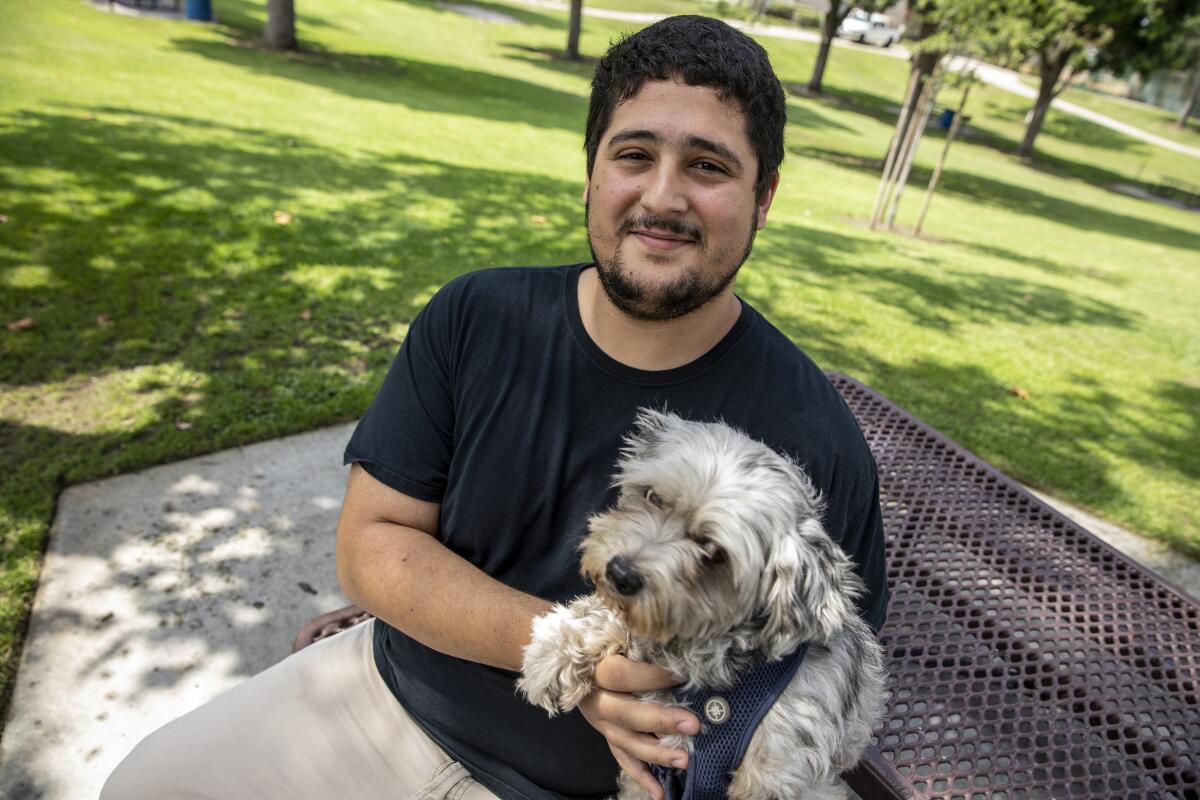
Meet Ulysses Sandoval and Chia. When the poodle mix needed surgery to remove a large stone in her bladder, Sandoval was having trouble finding a way to pay the $2,200 bill. He had lost his job during the pandemic.
As a very last resort, the Cudahy resident would have relinquished Chia to one of the seven animal shelters run by Los Angeles County. But when he called the one in Downey, he learned he wouldn’t have to. The shelter hooked him up with a $500 voucher as part of an approach called “managed intake.”
The idea is to provide assistance to animal owners so they can keep their pets. Plus, a strict appointment system and other measures make it more difficult for owners to surrender their four-legged companions.
Managed intake isn’t a new idea, but L.A. County decided to try it out when the pandemic forced officials to close shelters to the public. Since then, owner surrenders have fallen by 58% for dogs and 68% for cats. And with the shelters less crowded, respiratory illnesses among the animals there are down 53% for dogs and 82% for cats.
Don’t miss this story of one of the pandemic’s silver linings.
Resources
Need a vaccine? Keep in mind that supplies are limited, and getting one can be a challenge. Sign up for email updates, check your eligibility and, if you’re eligible, make an appointment where you live: City of Los Angeles | Los Angeles County | Kern County | Orange County | Riverside County | San Bernardino County | San Diego County | San Luis Obispo County | Santa Barbara County | Ventura County
Practice social distancing using these tips, and wear a mask or two.
Watch for symptoms such as fever, cough, shortness of breath, chills, shaking with chills, muscle pain, headache, sore throat and loss of taste or smell. Here’s what to look for and when.
Need to get tested? Here’s where you can in L.A. County and around California.
Americans are hurting in many ways. We have advice for helping kids cope, resources for people experiencing domestic abuse and a newsletter to help you make ends meet.
We’ve answered hundreds of readers’ questions. Explore them in our archive here.
For our most up-to-date coverage, visit our homepage and our Health section, get our breaking news alerts, and follow us on Twitter and Instagram.




